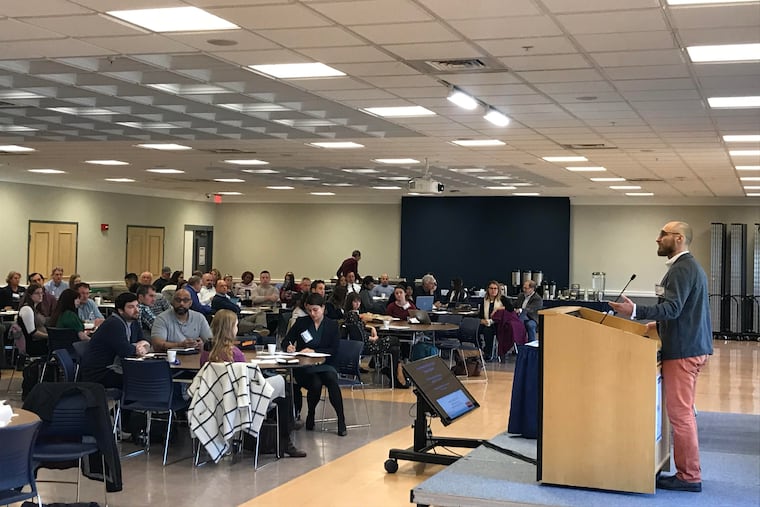What are drug-induced-homicide charges, and why are they so prevalent in Pennsylvania?
Prosecutors here file drug delivery resulting in death charges more than almost anywhere else in the country.

A Montgomery County woman initially sentenced to 21 years in federal prison for her role in a companion’s overdose death will likely see that punishment reduced at a court hearing on Friday.
It’s a case that brought renewed attention to the controversial prosecution of overdose deaths as homicides — a practice that’s particularly prevalent in state courts in Pennsylvania.
Emma Semler, 28, was convicted in 2019 for distributing heroin resulting in the 2014 death of Jenny Werstler, 20, whom she met in an addiction treatment program as a teenager.
On the night of Werstler’s 20th birthday in 2014, the two injected heroin together in the bathroom of a West Philadelphia Kentucky Fried Chicken. Werstler fatally overdosed; Semler and her younger sister, then 17, fled without alerting anyone.
Semler subsequently recovered from her addiction and has expressed remorse for Werstler’s death. After her conviction, she appealed, and a federal appeals court overturned the conviction and granted her a new trial.
Recently, she reached a plea agreement with prosecutors in exchange for a lesser sentence. (Her original 21-year sentence was the mandatory minimum for distributing heroin resulting in death, plus one year.)
While the case against Semler was filed by federal prosecutors, district attorneys in some Pennsylvania counties have used the state-equivalent charge aggressively. County prosecutors in Pennsylvania file charges for drug delivery resulting in death more than almost anywhere else in the country. Semler’s case has drawn renewed attention to such laws.
While prosecutors say the charges are a deterrent to dealers selling powerful illicit drugs, advocates for strategies that reduce the harmful consequences of drug addiction argue that such laws can deter people who use drugs from calling for help when a companion overdoses.
Here’s a primer on drug-induced-homicide laws and how often they’re leveled against Pennsylvanians.
What are drug-induced-homicide laws?
When someone dies of an overdose, drug-induced-homicide laws allow a prosecutor to hold the person who supplied the victim’s drugs responsible for their death. In federal court, where Semler is charged, a drug distribution charge can carry a weightier sentence if those drugs caused someone’s death.
In Pennsylvania, people who supply drugs involved in an overdose death can face a separate charge known as “drug delivery resulting in death” (DDRD). It’s become widely used by prosecutors as overdoses have spiked here; under the statute, people who sell or give drugs to someone who dies of an overdose can face a prison term of 20 to 40 years.
How do prosecutors use drug-induced-homicide charges?
Prosecutors have said that treating drug overdoses as homicides shows they’re committed to deterring overdoses, giving grieving families justice, and punishing large-scale dealers. But harm-reduction advocates have countered that many drug-induced homicide-charges target smaller dealers and drug users themselves instead.
In overturning Semler’s conviction, a federal appeals court ruled that the federal law had been applied too broadly and shouldn’t be used to punish people with addiction who used drugs with the overdose victim.
According to research from Northeastern University’s Health in Justice Action Lab, which analyzed media reports of drug-induced-homicide charges between 2000 and 2017, about 47% of the people charged with drug-induced-homicide nationwide between 2000 and 2017 fit the typical profile of a drug dealer — people who make their living selling drugs.
Family, friends, or caretakers of an overdose victim accounted for 50% of the charges, and 3% were doctors.
How does Pennsylvania compare to other states in pursuing such charges?
Between 2000 and 2017, 664 DDRD cases were filed in state courts in Pennsylvania, according to the Health in Justice lab. Prosecutors in Ohio, with the second-highest number of drug-induced-homicide cases, filed 385 in that period.
At the federal level, Pennsylvania’s three U.S. Attorney’s offices filed 92 drug-induced-homicide cases between 2014 and 2019.
More recent data from the Administrative Office of Pennsylvania Courts shows that between 2017 and 2021, prosecutors in Pennsylvania filed charges of drug delivery resulting in death 1,141 times. Lancaster County brought these charges most often in that time period, amounting to about 10% of the state’s cases. Locally, Bucks, Chester, and Montgomery Counties also bring the charge fairly often, making up 5%, 4%, and 3% of the state’s DDRD cases, respectively.
Pennsylvania’s high number of DDRD charges may stem in part from a 2011 change in state law that demoted DDRD from a murder charge to a first-degree felony. Now, all prosecutors have to prove in a DDRD case is that defendants distributed the fatal dose — not that they intended to kill the person who used it.
Still, many of these cases don’t make it to trial: Defendants plead guilty or, like Semler, work out plea agreements on lesser charges. In York County, which once led the state in DDRD charges, only four out of the 45 people charged with DDRD between 2013 and 2017 ever made it before a jury.
Staff writer Jeremy Roebuck contributed to this article.